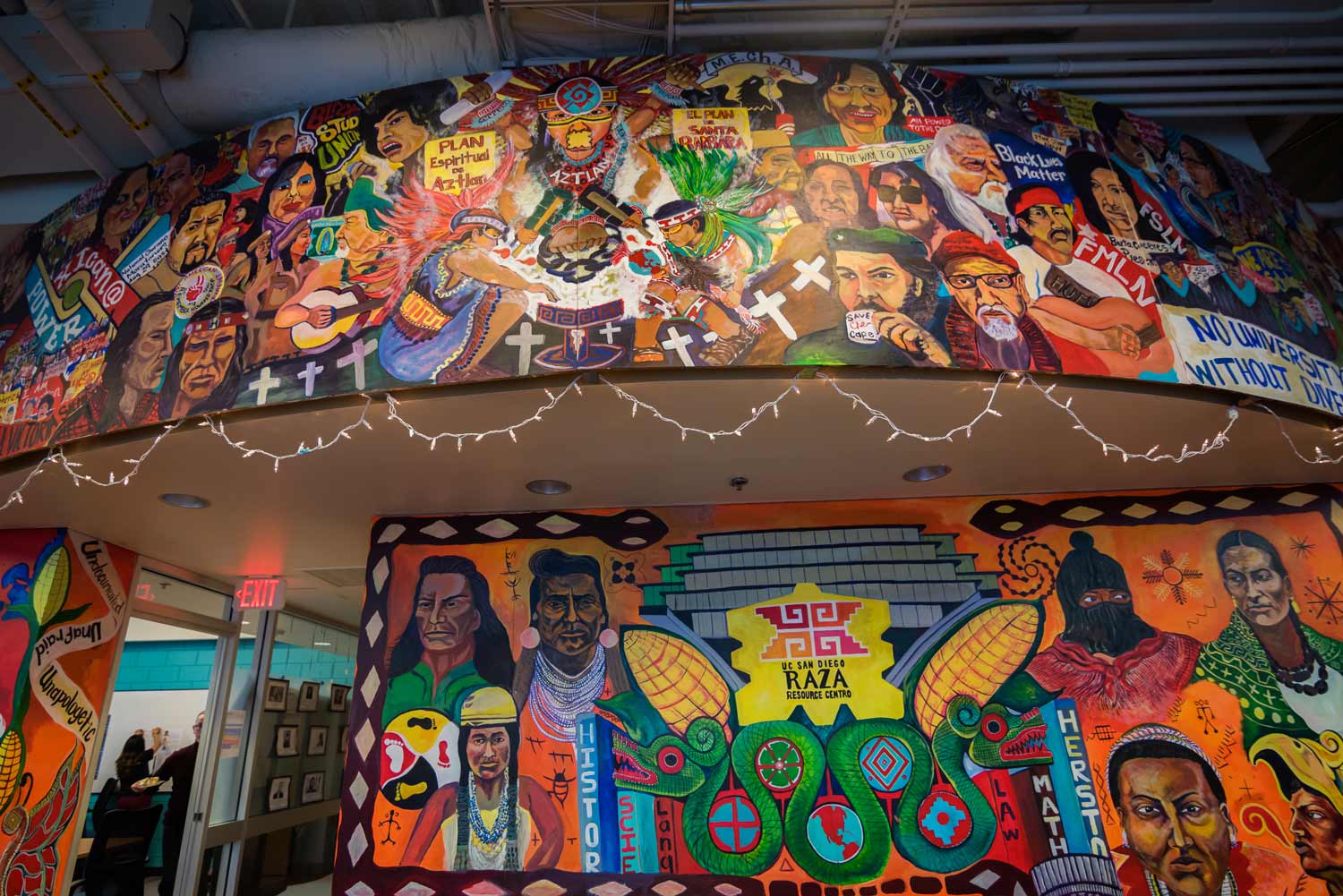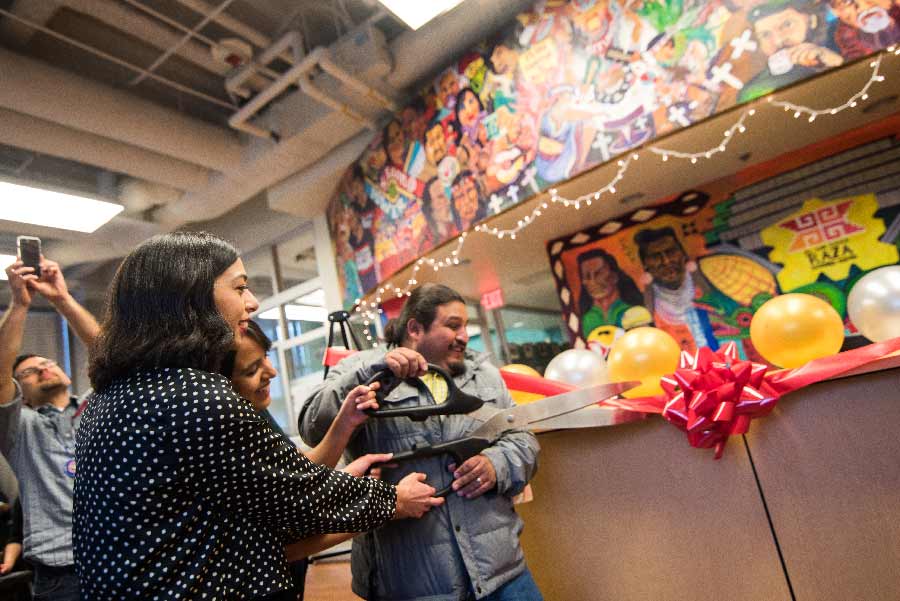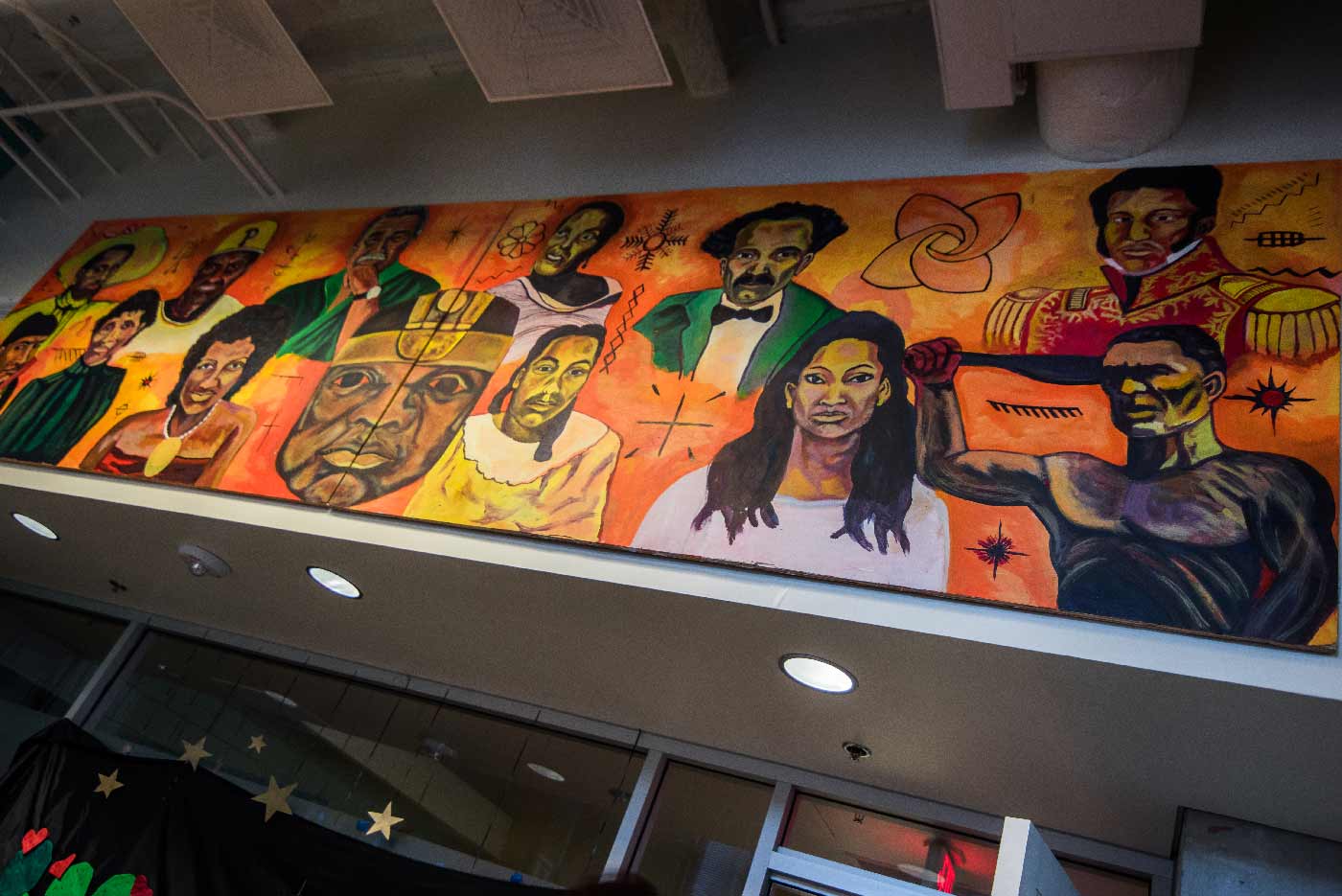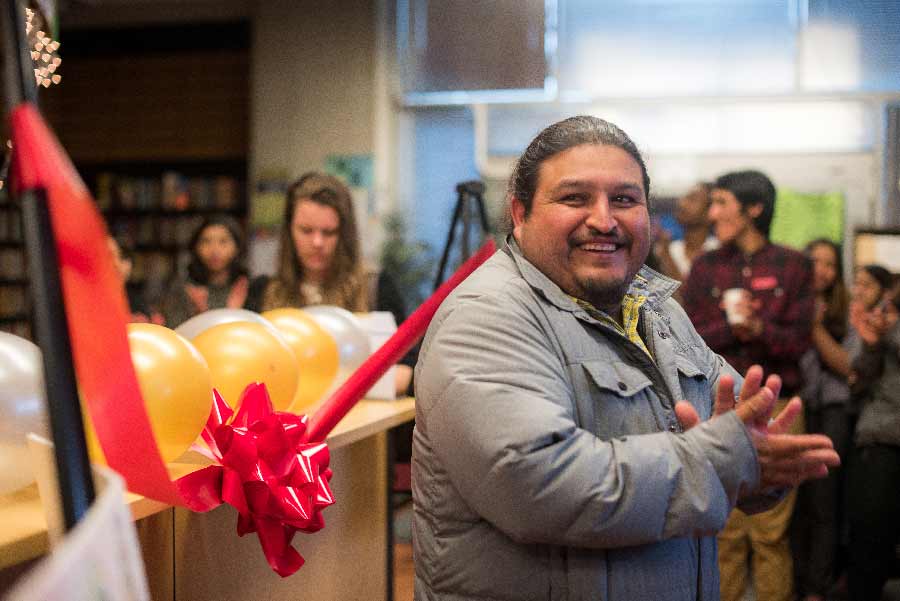By:
- Erika Johnson
Published Date
By:
- Erika Johnson
Share This:

Three new murals were unveiled at the Raza Resource Centro depicting indigenous roots, student activism and the African diaspora in Latin America. Photos by Lily Tang/UC San Diego Publications
The Art of Transformation
Three new murals unveiled at the Raza Resource Centro
When you walk into the Raza Resource Centro at UC San Diego, your gaze is immediately drawn to a prominent and vibrantly colored panorama depicting artists and activists, community builders and rebels—people who have defined, shaped and transformed Latino/a identity and empowerment throughout history. Three new murals were unveiled at a recent campus ceremony that included a talk by artist Jose Olague.
“It’s really empowering to see faces like mine and others represented in the mural,” said Daniella Tajimaroa, a sophomore and Arte y Cultura intern at the Raza Resource Centro. “It’s inspiring, not just for the representation, but knowing the history and advocacy work that was put in by students.”

A special ribbon cutting inaugurated the new murals after artist Jose Olague discussed the symbols, messages and figures in the works.
Guests at the mural unveiling were given an opportunity to view the finished works. They shared in an apple cider toast and enjoyed empanadas and other appetizers while exploring the new works. The project was introduced by Director Gerardo Arellano and Raza Resource Centro’s Arte y Cultura student interns Hatchly Galindo Moreno and Daniella Tajimaroa. Artist Jose Olague then offered insight into the symbols, messages and figures in the works, and finalized their completion with a ribbon cutting.
Directly behind the front desk is a mural honoring the indigenous revolutionaries and movements of Latin America. The image of Geisel Library and a winding snake is seen in the center, framed by maize and symbols such as the four corners. The painting also depicts numerous individuals, including a Kumeyaay woman and an Aztec warrior, as well as Mexican painter Frida Kahlo and Chief Joseph, leader of the Nez Perce Nation. Throughout, a deep message of scholarly transformation pervades the mural, but also a reminder to acknowledge roots, intersectional identities and decolonial thought.
Above this, a large narrative frieze details student activism in the local community and at UC San Diego, beginning with 1960s counterculture activist Angela Davis. This part of the mural validates the interconnections of activism and the production of scholars as a process of social justice. Local figures include Ramon “Chunky” Sanchez, community activist, artist and educator who was one of the founders of Chicano Park; Irene Mena, a Filipina-Mexican who is considered to be the honorary grandmother of the San Diego Brown Berets of Aztlan; and many more.
Undergraduate student Mayra Rodriguez is also portrayed in the mural. She shared that the painting is an important illustration of student advocacy for diversity and inclusion. “One of the biggest things in the mural that needed to be highlighted was the history and legacy of not only the Raza Resource Centro, but the whole movement of having more diversity at the university.” Rodriguez added, “The biggest honor is getting to do the work that I do. I don’t do it to be painted or glorified in any way.”

Portraits of notable artists, singers and activists are interwoven as a means to highlight the intersectionality of identities in Latin America.
The third mural is located in the conference room of the Raza Resource Centro and focuses on the African diaspora in Latin America as a means to complicate the dominant narratives of Latinidad. Portraits of notable artists, singers and activists are interwoven, including Cuban-American singer Celia Cruz, transgender Afro-Mexican revolutionary Colonel Carmen Amelio Robles Ávila and Colombian novelist Gabriel García-Márquez.
“The artistic beauty and rich social, cultural and historical representation depicted in the murals are a testament to inclusivity. I want to thank and acknowledge the students’ leadership on the mural project and the Raza Resource Centro staff for the guidance and coordination they provided to make the murals a reality,” said Vice Chancellor for Equity, Diversity and Inclusion Becky Petitt. “The murals are an extension of the welcoming feeling the RRC provides and they proudly state to our Latinx students: We see you. You matter.”
The murals were first envisioned in 2014 when the Raza Resource Centro was created. According to Arellano, listening sessions were held with student stakeholders to discover what they would like to see.
“Murals tell a story, they start a conversation,” explained Arellano. “What does intersectionality look like within the Latino/a identity and the growth of a scholar activist? How do we decolonize our mind and grow together as a community? It’s not easy to tell that story, but I think Jose did a good job capturing intersectionality. However, there are more stories to be told.”

Muralist Jose Olague explained that the works present an opportunity to have a dialogue about identity and community.
Artist Jose Olague worked closely with students and the Raza Resource Centro team to design a piece that would reflect the messages they wanted to convey. Olague has painted a mural in Chicano Park and regularly works with foster youth and other kids to teach them how to express their ideas through art. He was first encouraged to become a muralist by mentor Victor Ochoa, a Chicano Park muralist and community activist.
“Every part of the Raza Resource Centro mural was exciting for me to work on because it was a decolonizing learning experience,” shared Olague. “We have roots everywhere as Latino Americanos. The term ‘Raza’ isn’t just about one people, but rather the fusion between all the races in the Americas. The term has evolved, and I think UC San Diego’s Raza Resource Centro has created a space where the dialogue can continue.”
The Raza Resource Centro, among the newest of the campus community centers, is one of six spaces on campus dedicated to equity, diversity and inclusion. In 2014, a grand re-opening celebration was held in a newly renovated space on the first floor of the Student Services Center. The Centro offers a place for all students to find community, discover opportunities to develop academically and professionally, as well as engage in interactive learning about the diverse Chicano/a –Latino/a history and culture.
To learn more about the Raza Resource Centro, you can visit their website here. For more information about the UC San Diego Campus Community Centers, go here.
Share This:
You May Also Like
$10 Million Grant from Price Philanthropies Launches Behavioral Health Hub at UC San Diego Health
Health & BehaviorStay in the Know
Keep up with all the latest from UC San Diego. Subscribe to the newsletter today.



